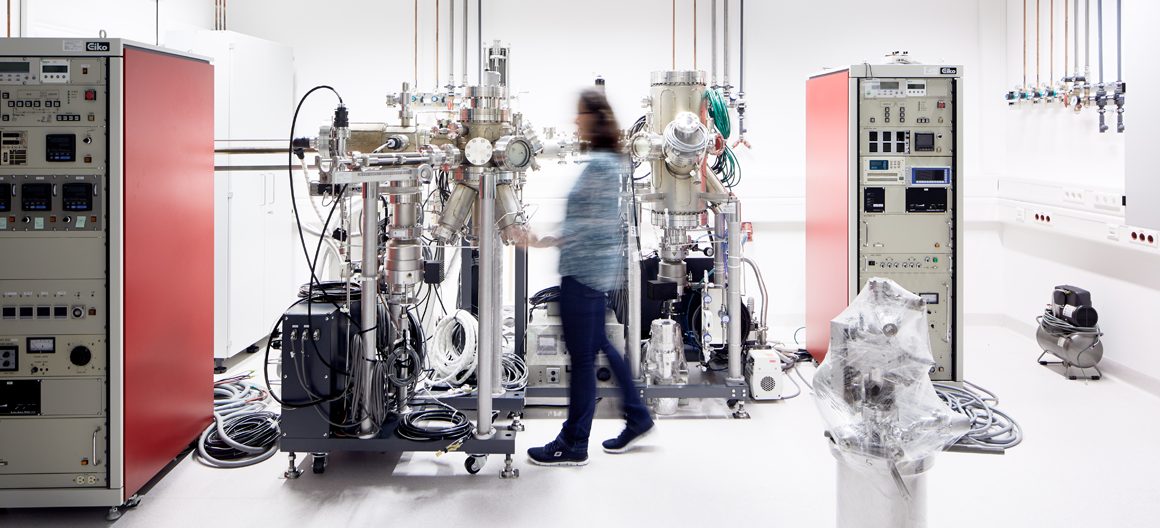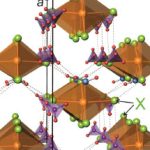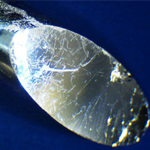
Simon Wegener
PROJECTS
Projekt Area A
Materials – preparation and characterization

A01 T. Michely (PII) / A, Kurzmann (PII) / I. Lindfors-Vrejoiu (PII)
Architecting 2D heterostructures for the control of electronic, optical and magnetic properties
Novel 2D material devices and systems are being developed to realize quantum dots, correlated phases and unique magnetic or dielectric properties. Materials with complex magnetic order and strong electron-phonon coupling are created by molecular beam epitaxy including intercalation methods. In transition metal dichalcogenides quantum dots will be fabricated to obtain a deeper understanding of their properties and assess their potential use as qubits. Furthermore, pulsed laser deposition is used to develop oxide heterostructures that have topologically non-trivial magnetic and polar textures with potential applications for data storage.
A02 P. Becker-Bohatý (IGM) / M. Braden (PII) / T. Lorenz (PII)
Crystal growth and design of materials
The aim of this project is the preparation, growth and characterization of crystalline samples, which form the basis of many projects of this CRC. The broad spectrum of applied experimental techniques ranges from various synthesis methods for polycrystalline samples to sophisticated crystal growth methods, such as zone melting using a mirror furnace or chemical transport reaction growth. In the project we will focus on cluster Mott insulators with 4d elements, on materials dominated by frustration and/or strong spin-orbit coupling, on Ruddlesden-Popper-type ruthenates and on the recently proposed class of altermagnetic materials.
A04 Y. Ando (PII) / O. Breunig (PII) / A. Taskin (PII)
Topological matter
In this project we explore the new physics of topological insulators (TI), topological semimetals and topological superconductors (TSC) by synthesis of bulk crystals, thin films and also nanowires. Besides the semimetal ZrTe5 we grow low-disorder TI single crystals and TSC candidates. For thin films of magnetic TIs, we aim at confirming chiral Majorana edge states in a quantum anomalous Hall insulator. TI Nanowires are grown and fabricated to search for signatures of topological superconductivity.
Projekt Area B
Physical properties

B01 Y. Ando (PII) / O. Breunig (PII) / T. Lorenz (PII)
Transport and thermodynamics
Topology has proved extremely fruitful in classifying matter. Here, we want to use topological materials as a basis for exploring further exotic phases that can emerge from them. By using clean room fabrication, we will, for example, induce superconductivity into topological insulators with the prospect of realizing and studying Majorana modes. Via quantum transport and thermodynamics we will study these devices and also bulk crystals of topological and magnetically frustrated matter in order to explore Skyrmion and spin-liquid phases, as well as the influence of charge puddles on the thermal transport properties.
B03 M. Grüninger (PII) / P. van Loosdrecht (PII)
Inelastic photon scattering in spin-orbit coupled matter
Using resonant inelastic x-ray scattering (RIXS) and Raman scattering, we address the rich physics in correlated quantum materials with strong spin-orbit coupling. Our three central topics are: Controlling quasimolecular magnetic moments and exchange interactions in cluster Mott insulators; unraveling hidden multipolar order via magnetic excitations; and exploring novel, exotic excitations such as bond-directional excitations in Kitaev materials, chiral and non-reciprocal excitations in Dirac matter, and fractionalization vs. many-body bound states in anisotropic quasi-onedimensional magnets.
B04 M. Braden (PII)
Dynamics and correlations studied by neutron scattering
The magnetic and nuclear structure and the associated excitations shall be studied by various neutron scattering techniques to explore the impact of Weyl points on the spin-dynamics and the role of the latter in unconventional superconductivity. Furthermore, we will search for signatures of altermagnetic order in the magnetic structure as well as in the magnetic dynamics, study frustrated magnets with strong spin-orbit coupling and investigate the control of antiferromagnetic order by currents.
B05 P. van Loosdrecht (PII)
Optically driven matter
Optically driving materials into a non-equilibrium state opens the way to obtain a detailed understanding of the interactions between the magnetic, orbital, electronic, and lattice degrees of freedom which determine the physical properties of a material. At the same time, it also provides the means to coherently or incoherently drive systems into novel states of matter. Overarching goals of this project are advancing our understanding of interacting highly non-equilibrium states, discovery of novel optically induced states and phases, and optical control of properties of matter.
B06 J. Brede (PII) / W. Jolie (PII) / T. Michely (PII)
Scanning tunneling spectroscopy
Objective of the project is to investigate, manipulate, and control new correlated states and their phases in topological and two-dimensional materials on the local scale. To this end, strategies that go beyond conventional scanning tunneling spectroscopy will be employed: in situ growth of the materials under ultra-high vacuum, contactless doping and electrostatic gating, spin-polarized tunneling spectroscopy at variable magnetic fields, atomic manipulation, and local investigations in hybrid devices.
B07 E. Bocquillon (PII) / J. Hemberger (PII)
Static and dynamic control of excitations in topological quantum matter
Using microwave techniques in the GHz range for spectroscopy or transport experiments, this project addresses the dynamics and control of magnetic or electronic excitations in topological quantum materials. The subjects reach from edge plasmons in the quantum anomalous Hall effect considering the possible influence of charge puddles in bulk and surface, include phase transitions in planar Josephson junctions and the control of embedded magnetic domain walls, as well as the stimulation of magnetic modes in skyrmion crystals and chiral magnets in terms of driven phases in active matter.
Projekt Area C
Theory

C01 N. Atodiresei (FZJ) / S. Blügel (FZJ)
Structure inversion-asymmetric matter and spin-orbit phenomena from ab initio
We study the electronic structure of two-dimensional van der Waals materials on substrates and as heterostructures. We apply this knowledge to analyze magnetic interactions, study spin structures (e.g., merons and skyrmions), explore transport properties, design systems with controllable properties, and control functionalities. We will perform ab initio studies and utilize the predictive power of density functional theory to investigate novel phenomena that are influenced by the subtle interplay of spin-orbit interactions, structural inversion asymmetry, competing magnetic interactions, charge transfer, elastic deformations, and the interaction of electrons with lattice vibrations.
C02 A. Rosch (ITP) / M. Scherer (RUB) / S.Trebst (ITP)
Spin-orbit driven topological and correlated states and Dirac matter
Spin and orbital degrees of freedom play a pivotal role in many novel quantum materials, including moiré heterostructures or frustrated magnets. Their interplay can give rise to exotic states of matter. In this project, we advance theories to clarify pairing mechanisms and topological properties of superconducting and other phases in correlated heterostructures. The project also serves as a hub for investigating spin-orbit coupled matter in collaboration with experiments. We develop theories for the giant non-linear transport and Hall effects observed in disordered topological matter and study Luttinger liquids arising from structural and magnetic domains walls.
C03 S. Diehl (ITP) / U. Seifert (ITP) / S.Trebst (ITP)
Dynamics and fractionalization in spin-orbit entangled matter
Fractionalization is a key example for the exotic phenomena offered by quantum many-body systems, and a defining characteristic of spin liquids. Their dynamics out-of-equilibrium are little explored to date. Our goals are twofold: (i) To uncover spectroscopic signatures of such states, for which we will study pump-probe spectroscopy of gapless Dirac spin liquids, and simulate novel 2D coherent spectroscopy protocols for quantum magnets. (ii) To develop a field theoretical framework for the dynamics of driven open systems, applying it to both optically driven TiSe2, and to investigate the possibility of inducing spin liquids by optical pumping of Kitaev-Heisenberg models.
C04 S. Diehl (ITP) / A. Rosch (ITP)
Active quantum matter
Driving quantum materials out of equilibrium is generically hard. We suggest to target soft modes as a solution to this problem. Under the header ‘active quantum matter’, we explore their universal phenomenology: (i) We study the impact of dynamically activated Goldstone modes and topological defects on paradigms such as the Mermin-Wagner theorem and the Kibble-Zurek scenario, including the effects of disorder. (ii) We propose solid state realizations of the famous non-equilibrium Kardar-Parisi-Zhang universality class, e.g. for experiments on planar Josephson junctions. (iii) We break new ground by establishing the universality class for time crystalline phases of matter.
C05 C. Kollath (PIB)
Driven quantum matter
We will investigate theoretically quantum materials under extreme non-equilibrium conditions extending and developing advanced numerical methods. The subjects reach from the dynamics and 2D spectroscopy of complex high energy states, as repulsively bound states, in quantum materials to phenomena as active matter or the influence of phononic modes on the dynamics of a system.